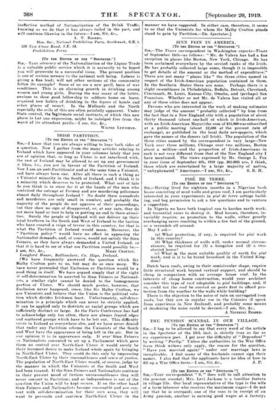PISE DE TERRE.
[To THE EDITOR OF THE " SPECTATOR."] Ste,—Having lived for eighteen months in *a Nigerian bush house consisting of mud walls and grass roof, I am particularly interested in your experiments in pise de terre cottage build- ing, and beg permission to ask a few questions and to venture a suggestion.
In Nigeria we have both tropical sun to harden earth work, and torrential rains to destroy it. Mud houses, therefore, in- variably require; as protection to. the walls, either greatly overhanging eaves reaching to within a few feet of the ground, or a verandah all around.
May I ask— .
(a) What protection, if ally, is required for pise work in this country?
(b) What thickness of walls will, under normal circum- stances, be required for (1) a bungalow slid (2) a two- storied house?
(c) What is the most suitable quality of earth for pis4 Work, and is it to be found broadcast in the United King- dom?
Dutch barn roofs, owing to their semicircular shape, require little structural work beyond vertical support, and should be cheap in comparison with an average house roof. In the interests of cheap house construction, would your architect consider this type of roof adaptable to pise buildings, and, if so, could not the roof be erected on posts first to afford pro- tection from the weather to the walls while building?
There is the objection to the noise of rain on cprrugated iron roofs, but they are in regular use in the Colonies (I speak from experience in New Zealand), and probably some means of deadening the noise could be devised.—I am, Sir, &c.,
A NIGERIAN READER.






































 Previous page
Previous page